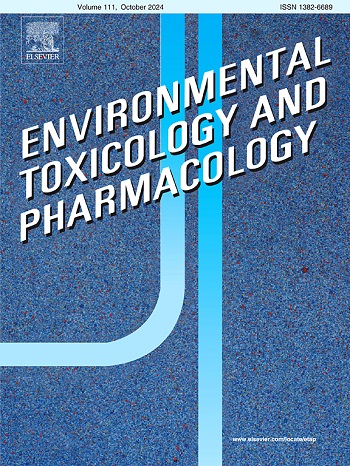The 24p3 receptor is implicated in cadmium-induced distal tubule nephrotoxicity
IF 4.2
3区 环境科学与生态学
Q2 ENVIRONMENTAL SCIENCES
引用次数: 0
Abstract
Accumulation of toxic metal cadmium (Cd) in the kidney is traditionally associated with proximal tubule (PT) toxicity, but the potential involvement of the distal tubule (DT) remains less explored. A previous study suggested a role of the 24p3 receptor (24p3R), expressed in the DT, in mediating cadmium-induced damage, particularly when PT function was compromised. A murine model (C57BL/6 J male mice) employing gentamicin (GM) to impair PT reabsorption was used to redirect cadmium–metallothionein (CdMT) complexes toward the distal segment. Here, we used the same model, confirming that DT-specific injury was evident following CdMT administration, including epithelial cell flattening, vacuolization, enhanced catalase activity, lipid peroxidation, and apoptotic cell death. Cd exposure increased 24p3R expression in the DT, supporting its involvement in metal uptake. Coadministration of 24p3, an endogenous ligand of 24p3R, with CdMT significantly reduced tissue Cd levels by 75 % and alleviated histological and biochemical markers of injury, suggesting that 24p3 competes with CdMT for receptor binding, limiting Cd entry and its downstream toxicity. Administration of 24p3 alone did not provoke structural or molecular alterations in renal tissue. The results identify 24p3R as a relevant pathway in DT-targeted cadmium nephrotoxicity and highlight the potential of 24p3-based strategies for mitigating renal injury due to exposure to potentially toxic elements.
24p3受体参与镉诱导的远端肾小管肾毒性
传统上认为,毒性金属镉(Cd)在肾脏中的积累与近端小管(PT)毒性有关,但远端小管(DT)的潜在影响仍未得到充分探讨。先前的一项研究表明,在DT中表达的24p3受体(24p3R)在介导镉诱导的损伤中起作用,特别是当PT功能受损时。采用庆大霉素(GM)损伤PT重吸收的小鼠模型(C57BL/6J雄性小鼠),将镉-金属硫蛋白(CdMT)复合物向远端节段转移。在这里,我们使用了相同的模型,证实CdMT给药后dt特异性损伤是明显的,包括上皮细胞变平、空泡化、过氧化氢酶活性增强、脂质过氧化和凋亡细胞死亡。Cd暴露增加了24p3R在DT中的表达,支持其参与金属摄取。24p3是24p3R的内源性配体,与CdMT共给药可显著降低75%的组织Cd水平,减轻组织和生化损伤标志物,表明24p3与CdMT竞争受体结合,限制了Cd的进入及其下游毒性。单独给药24p3不会引起肾组织的结构或分子改变。研究结果确定24p3R是dt靶向镉肾毒性的相关途径,并强调了基于24p3的策略在减轻暴露于潜在有毒元素引起的肾损伤方面的潜力。
本文章由计算机程序翻译,如有差异,请以英文原文为准。
求助全文
约1分钟内获得全文
求助全文
来源期刊
CiteScore
7.00
自引率
4.70%
发文量
185
审稿时长
34 days
期刊介绍:
Environmental Toxicology and Pharmacology publishes the results of studies concerning toxic and pharmacological effects of (human and veterinary) drugs and of environmental contaminants in animals and man.
Areas of special interest are: molecular mechanisms of toxicity, biotransformation and toxicokinetics (including toxicokinetic modelling), molecular, biochemical and physiological mechanisms explaining differences in sensitivity between species and individuals, the characterisation of pathophysiological models and mechanisms involved in the development of effects and the identification of biological markers that can be used to study exposure and effects in man and animals.
In addition to full length papers, short communications, full-length reviews and mini-reviews, Environmental Toxicology and Pharmacology will publish in depth assessments of special problem areas. The latter publications may exceed the length of a full length paper three to fourfold. A basic requirement is that the assessments are made under the auspices of international groups of leading experts in the fields concerned. The information examined may either consist of data that were already published, or of new data that were obtained within the framework of collaborative research programmes. Provision is also made for the acceptance of minireviews on (classes of) compounds, toxicities or mechanisms, debating recent advances in rapidly developing fields that fall within the scope of the journal.

 求助内容:
求助内容: 应助结果提醒方式:
应助结果提醒方式:


